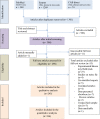Global distribution, host range and prevalence of Trypanosoma vivax: a systematic review and meta-analysis
- PMID: 33494807
- PMCID: PMC7830052
- DOI: 10.1186/s13071-021-04584-x
Global distribution, host range and prevalence of Trypanosoma vivax: a systematic review and meta-analysis
Abstract
Background: Trypanosomosis caused by Trypanosoma vivax is one of the diseases threatening the health and productivity of livestock in Africa and Latin America. Trypanosoma vivax is mainly transmitted by tsetse flies; however, the parasite has also acquired the ability to be transmitted mechanically by hematophagous dipterans. Understanding its distribution, host range and prevalence is a key step in local and global efforts to control the disease.
Methods: The study was conducted according to the methodological recommendations of the Preferred Reporting Items for Systematic Reviews and Meta-Analyses (PRISMA) checklist. A systematic literature search was conducted on three search engines, namely PubMed, Scopus and CAB Direct, to identify all publications reporting natural infection of T. vivax across the world. All the three search engines were screened using the search term Trypanosoma vivax without time and language restrictions. Publications on T. vivax that met our inclusion criteria were considered for systematic review and meta-analysis.
Result: The study provides a global database of T. vivax, consisting of 899 records from 245 peer-reviewed articles in 41 countries. A total of 232, 6277 tests were performed on 97 different mammalian hosts, including a wide range of wild animals. Natural infections of T. vivax were recorded in 39 different African and Latin American countries and 47 mammalian host species. All the 245 articles were included into the qualitative analysis, while information from 186 cross-sectional studies was used in the quantitative analysis mainly to estimate the pooled prevalence. Pooled prevalence estimates of T. vivax in domestic buffalo, cattle, dog, dromedary camel, equine, pig, small ruminant and wild animals were 30.6%, 6.4%, 2.6%, 8.4%, 3.7%, 5.5%, 3.8% and 12.9%, respectively. Stratified according to the diagnostic method, the highest pooled prevalences were found with serological techniques in domesticated buffalo (57.6%) followed by equine (50.0%) and wild animals (49.3%).
Conclusion: The study provides a comprehensive dataset on the geographical distribution and host range of T. vivax and demonstrates the potential of this parasite to invade other countries out of Africa and Latin America.
Keywords: Domestic animals; Global distribution; Host species; Meta-analysis; Pooled prevalence; Trypanosoma vivax; Wild fauna.
Conflict of interest statement
The authors declare that they have no competing interests.
Figures



Similar articles
-
Study on the sequential tsetse-transmitted Trypanosoma congolense, T. brucei brucei and T. vivax infections to African buffalo, eland, waterbuck, N'Dama and Boran cattle.Vet Parasitol. 1999 Jan 14;80(3):197-213. doi: 10.1016/s0304-4017(98)00209-x. Vet Parasitol. 1999. PMID: 9950344
-
Systematic review and meta-analysis on the global distribution, host range, and prevalence of Trypanosoma evansi.Parasit Vectors. 2019 Jan 31;12(1):67. doi: 10.1186/s13071-019-3311-4. Parasit Vectors. 2019. PMID: 30704516 Free PMC article.
-
Tsetse blood-meal sources, endosymbionts and trypanosome-associations in the Maasai Mara National Reserve, a wildlife-human-livestock interface.PLoS Negl Trop Dis. 2021 Jan 6;15(1):e0008267. doi: 10.1371/journal.pntd.0008267. eCollection 2021 Jan. PLoS Negl Trop Dis. 2021. PMID: 33406097 Free PMC article.
-
A national atlas of tsetse and African animal trypanosomosis in Mali.Parasit Vectors. 2019 Oct 9;12(1):466. doi: 10.1186/s13071-019-3721-3. Parasit Vectors. 2019. PMID: 31597558 Free PMC article.
-
African Animal Trypanosomiasis: A Systematic Review on Prevalence, Risk Factors and Drug Resistance in Sub-Saharan Africa.J Med Entomol. 2022 Jul 13;59(4):1099-1143. doi: 10.1093/jme/tjac018. J Med Entomol. 2022. PMID: 35579072
Cited by
-
An Atlas of Surra in Spain: A Tool to Support Epidemiological Investigations and Disease Control.Animals (Basel). 2024 Jan 12;14(2):243. doi: 10.3390/ani14020243. Animals (Basel). 2024. PMID: 38254411 Free PMC article.
-
Trypanosoma vivax elicits both Th1 and Th2 immunological responses in experimentally infected cattle.PLoS One. 2025 Jul 31;20(7):e0329459. doi: 10.1371/journal.pone.0329459. eCollection 2025. PLoS One. 2025. PMID: 40743218 Free PMC article.
-
An atlas to support the progressive control of tsetse-transmitted animal trypanosomosis in Burkina Faso.Parasit Vectors. 2022 Mar 4;15(1):72. doi: 10.1186/s13071-021-05131-4. Parasit Vectors. 2022. PMID: 35246216 Free PMC article.
-
Differences in Transporters Rather than Drug Targets Are the Principal Determinants of the Different Innate Sensitivities of Trypanosoma congolense and Trypanozoon Subgenus Trypanosomes to Diamidines and Melaminophenyl Arsenicals.Int J Mol Sci. 2022 Mar 5;23(5):2844. doi: 10.3390/ijms23052844. Int J Mol Sci. 2022. PMID: 35269985 Free PMC article.
-
Vector-borne zoonotic blood parasites in wildlife from Ecuador: A report and systematic review.Vet World. 2021 Jul;14(7):1935-1945. doi: 10.14202/vetworld.2021.1935-1945. Epub 2021 Jul 27. Vet World. 2021. PMID: 34475720 Free PMC article.
References
-
- Stevens J., Brisse S. Systematics of trypanosomes of medical and veterinary importance. In: Maudlin I, Holmes P., Miles M., editors. Trypanos. CABI Publishing; 2004. p. 1–19.
-
- Luckins AG, Dwinger RH. Non-tsetse-transmitted animal trypanosomiasis. In: Maudlin I, Holmes PH, Miles MA, editors. Trypanos. CABI Publishing; 2004. p. 269–79.
-
- Vieira OLE, de Macedo LO, Santos MAB, Silva JABA, de Mendonca CL, da Faustino MAG, et al. Detection and molecular characterization of Trypanosoma (Duttonella) vivax in dairy cattle in the state of Sergipe, northeastern Brazil. Rev Bras Parasitol Vet Brazil. 2017;26:516–520. doi: 10.1590/s1984-29612017048. - DOI - PubMed
-
- Kassian EN, Simuunza MC, Silayo RS, Moonga L, Ndebe J, Sugimoto C, et al. Prevalence and risk factors of bovine trypanosomosis in Kilwa district, Lindi region of southern Tanzania. Vet Parasitol Reg Stud Reports. 2017;9:1–5. - PubMed
Publication types
MeSH terms
LinkOut - more resources
Full Text Sources
Other Literature Sources
Miscellaneous

